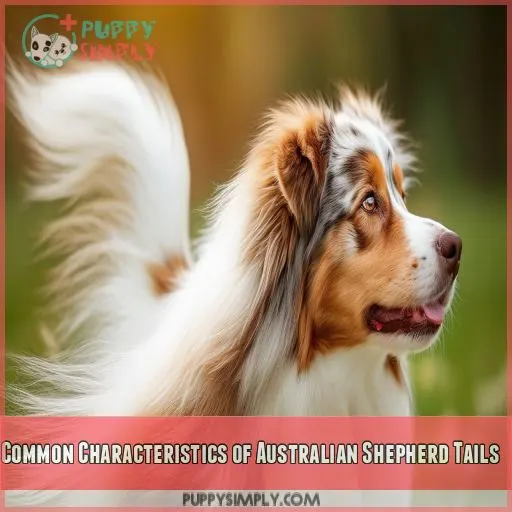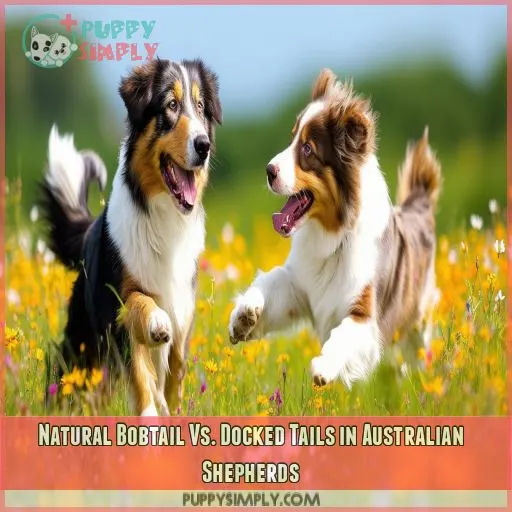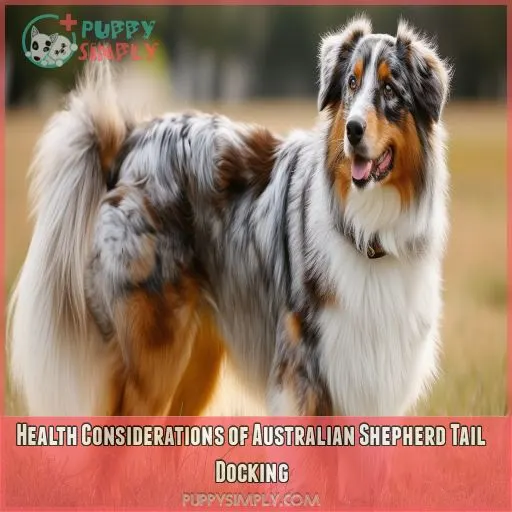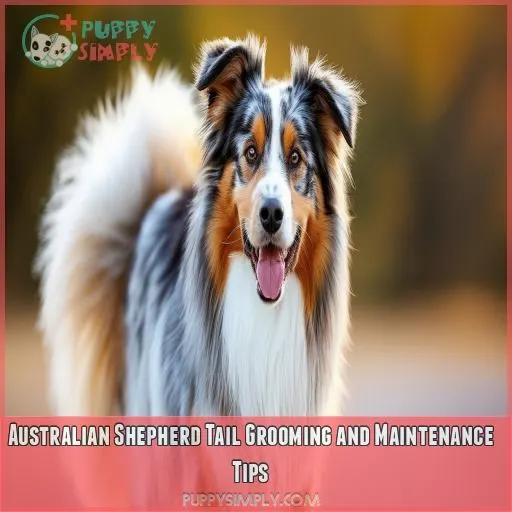This site is supported by our readers. We may earn a commission, at no cost to you, if you purchase through links.

You’ve come to the right place. We’ll explain everything you need to know about Aussie tails, from natural bobtails to the controversial practice of tail docking.
Table Of Contents
- Key Takeaways
- Are Australian Shepherds Born With Tails?
- Common Characteristics of Australian Shepherd Tails
- Natural Bobtail Vs. Docked Tails in Australian Shepherds
- Historical Context of Tail Docking in Australian Shepherds
- Health Considerations of Australian Shepherd Tail Docking
- Breeding Implications for Bobtailed Australian Shepherds
- Understanding Australian Shepherd Tail Wagging Signals
- Australian Shepherd Tail Grooming and Maintenance Tips
- Tail Docking Debate: Should You Dock Your Aussie’s Tail?
- Frequently Asked Questions (FAQs)
- Do Australian Shepherds have tails?
- Are Australian Shepherd tails faulty?
- How long are Australian Shepherd tails?
- Do Australian Shepherds have tails docked?
- Can Australian Shepherds have tails?
- Why do they cut Australian Shepherd tails?
- Are miniature Australian shepherds born with tails?
- Are Australian Shepherds born with tails on Reddit?
- How do I know if my Aussie is scared?
- Can I dock my Aussies tail myself?
- What does it mean if my Aussie holds their tail high?
- How do I keep my Aussies tail clean?
- How common is tail docking?
- Conclusion
Key Takeaways
- Australian Shepherds are born with tails, and about 20% of them have natural bobtails due to a specific gene.
- The length and shape of an Aussie’s tail vary, with natural tails typically measuring 10 to 15 inches or longer, and the shape often tapering to the end.
- The debate around natural bobtails and docked tails considers health risks, ethics, and aesthetics; docking is a personal choice, but it’s essential to weigh the pros and cons for your dog’s individual needs.
- An Australian Shepherd‘s tail is a form of communication, with different positions and movements indicating various moods and emotions, from happiness to fear.
Are Australian Shepherds Born With Tails?
Australian Shepherds are born with tails.
About 20% of Aussies are born with a natural bobtail due to a specific gene.
This bobtail gene is similar to the merle coat pattern gene in that it’s an incomplete dominant trait.
Puppies only need one copy of the gene to be born with a bobtail, and breeding for this trait can be risky.
Keep in mind that the bobtail gene doesn’t determine the exact length or shape of the tail.
Common Characteristics of Australian Shepherd Tails
Now that you know Australian Shepherds can be born with tails, let’s explore the common characteristics of their tails.
The length of an Australian Shepherd’s tail varies, with natural tails typically measuring between 10 to 15 inches or longer. However, due to breed standards and other factors, many Aussies have their tails docked to be 4 inches or shorter.
In terms of tail type, the majority of Australian Shepherds fall into one of two categories: natural bobtails (NBT) or docked tails. The NBT gene is an incomplete dominant trait, meaning a puppy only needs one copy of the gene to be born with a natural bobtail. About 1 in 5 Aussies are born with this tail type, which is usually around a quarter length or longer.
The shape of an Aussie’s tail can vary, but it typically tapers to the end. The tail may be carried in a gentle curve or with a slight upward hook at the tip. Some Aussies have straight tails, while others may have a slight kink or curve, which is considered a malformation by breed standards.
When it comes to color, the tail of an Australian Shepherd typically matches the color of the dog’s coat, often featuring a combination of merle, black, red, or white. The texture of the tail fur is generally smooth and sleek, in keeping with the overall appearance of the breed.
Natural Bobtail Vs. Docked Tails in Australian Shepherds
Now that you’re familiar with the characteristics of Australian Shepherd tails, let’s talk about the debate surrounding natural bobtails (NBT) and docked tails in this breed. About 20% of Aussies are born with a natural bobtail, and it’s all due to genetics. The NBT gene is incomplete dominant, so a puppy only needs one copy to sport a bobtail. However, breeding specifically for bobtails can be tricky. It can increase the risk of health issues and limit the gene pool.
On the other hand, many Australian Shepherds have their tails docked shortly after birth, primarily for aesthetic reasons or to prevent tail injuries. This practice has been a part of the breed’s history, especially for working dogs and show dogs, but it’s becoming less common as natural tails gain popularity. Docking is a personal choice, and you need to weigh the pros and cons for your dog’s individual needs and lifestyle.
Historical Context of Tail Docking in Australian Shepherds
The tradition of docking Australian Shepherds‘ tails has a long history, dating back to Roman times when it was believed to prevent rabies.
However, the specific practice of docking Aussie tails to conform to breed standards is a more recent development, beginning in the 1950s with the establishment of AKC breed standards.
Docking was initially done for both aesthetic and practical reasons, as the breed’s traditional blunt or kinked tails were considered undesirable, and long tails could potentially lead to injuries for working dogs.
Today, the decision to dock an Aussie’s tail is a personal one, with some breeders choosing to leave their dogs’ tails intact to preserve their natural beauty and functionality.
Health Considerations of Australian Shepherd Tail Docking
If you’re thinking about breeding bobtailed Aussies, there are some health considerations to keep in mind. While the natural bobtail trait is desirable to some, breeding specifically for bobtails can increase the risk of certain health issues, like spina bifida, and limit the gene pool, potentially leading to other health complications.
Breeding Risks
Breeding bobtails isn’t without its challenges. Here are some health considerations to keep in mind:
- Spina Bifida: Breeding for bobtails can increase the risk of this serious birth defect.
- Limited Gene Pool: Breeding bobtails can reduce genetic diversity, leading to potential health issues down the line.
- Health Complications: While a natural bobtail is cute, it’s important to prioritize health and temperament over tail length when breeding.
Pain Debate
The ethical debate surrounding tail docking and puppy pain is a complex one.
Some argue that puppies don’t feel pain during the procedure, as their nervous system isn’t fully developed.
However, others disagree, stating that the puppies do experience pain and that it can be a traumatic experience for them.
With no definitive answer, it’s a matter of personal belief and values.
Tail Function
The Australian Shepherd’s tail is a powerful tool for communication and expression. A wagging tail conveys happiness and excitement, while a tucked tail signals fear or anxiety. A high tail indicates confidence and alertness, and a low tail shows submission. Understanding these tail emotions helps owners better understand their dog’s mood and strengthens their bond.
Although some owners believe that tail docking impacts a dog’s balance and coordination, there’s no scientific evidence to support this claim.
Breeding Implications for Bobtailed Australian Shepherds
Breeding bobtailed Australian Shepherds involves a few key considerations, especially regarding health, ethics, and the AKC breed standard. The gene responsible for bobtails can lead to serious health risks, including an increased likelihood of spina bifida in puppies. Breeding for bobtails can also limit the gene pool and potentially impact the overall health of the litter.
From an ethical standpoint, responsible breeders prioritize the health and temperament of their dogs over specific physical traits. While the AKC breed standard doesn’t disqualify natural bobtails, it emphasizes that the tail should be in balance with the dog’s overall structure.
Understanding Australian Shepherd Tail Wagging Signals
Now that you’re familiar with the implications of breeding bobtailed Australian shepherds, let’s shift our focus to understanding the tail wagging signals of these fascinating dogs.
As you may know, a dog’s tail isn’t just an appendage; it’s a powerful means of communication. By paying attention to the different ways your Aussie wags its tail, you can gain valuable insights into their mood and emotions.
For instance, a big, carefree wag accompanied by eye contact and enthusiastic jumping is often a sign of greeting or affection. On the other hand, a tucked tail can indicate fear or anxiety, while a high-held, rigid tail may signal aggression or alertness.
Additionally, the position of the tail in relation to the body can provide clues about your dog’s emotional state. For example, a tail held slightly down with gentle, backward wagging could mean your Aussie is curious but unsure. Conversely, a tail tucked between the legs with slight movement often indicates nervousness or fear, especially when accompanied by whining, crying, or shaking.
Australian Shepherd Tail Grooming and Maintenance Tips
Now that you’ve learned to interpret your Aussie’s tail language, it’s time to focus on tail grooming and hygiene. Here are some tips to keep your Aussie’s tail looking and feeling its best:
- Aussies with long tails need regular brushing and de-shedding to prevent matting and keep the tail clean and free from debris.
- Pay extra attention to tail hygiene, especially if your Aussie has a long tail. Make sure to clean the area around the tail, including the base of the tail and the hindquarters, to prevent skin irritation and infection.
- If your Aussie has a natural tail, be mindful of potential tail injuries, especially when they’re playing or running through brush or tall grass. Regular trimming of the tail hair can help prevent this.
- When bathing your Aussie, use a gentle shampoo and conditioner to maintain the natural oils in their coat and avoid drying out their skin. This will help keep their tail hair healthy and shiny.
Tail Docking Debate: Should You Dock Your Aussie’s Tail?
Should You Dock Your Aussie’s Tail?
The decision to dock your Australian Shepherd’s tail is a personal one, and there are various factors to weigh, including ethics, tradition, health, safety, and aesthetics.
| Factor | Consideration |
|---|---|
| Ethics | Some view tail docking as inhumane, arguing that it causes unnecessary pain and trauma to puppies. |
| Tradition | Tail docking has a long history, dating back to Roman times, and is often done to conform to breed standards, such as those set by the AKC. |
| Health | While docking is generally safe when performed by a qualified veterinarian, there are risks, including infection and healing complications. |
If your Aussie already has a tail, it’s best to leave it as is. For those choosing a puppy, think about skipping docking unless there are specific circumstances that make it necessary. Docking can be beneficial for working dogs in certain environments, but it’s not a requirement for family companion dogs.
Ultimately, the decision to dock or not comes down to individual circumstances and preferences. Research the pros and cons, and choose what’s best for your dog’s lifestyle and needs. Both docked and naturally-tailed Aussies make wonderful companions, and their tail length doesn’t define their capabilities or health.
Frequently Asked Questions (FAQs)
Do Australian Shepherds have tails?
Yes, Australian Shepherds can have tails, but about 20% are born with naturally bobbed tails. Most have their tails docked within three days of birth.
Are Australian Shepherd tails faulty?
It depends on who you ask. Some consider long tails, tails over a quarter of their normal length, and kinked or curled tails to be faulty. Others argue that there’s no "correct" tail type.
How long are Australian Shepherd tails?
Natural tails are typically 10-15 inches long, docked tails are usually 4 inches or shorter, and natural bobtails are generally 3-4 inches long.
Do Australian Shepherds have tails docked?
It’s a dog-eat-dog world, and Australian Shepherds are no exception. Many have their tails docked, but it’s becoming less common. Docking is usually for cosmetic reasons or to meet breed standards. It’s a controversial topic, with some considering it unnecessary and potentially painful.
Can Australian Shepherds have tails?
Yes, Australian Shepherds can have tails. About 20% are born with a naturally bobbed tail, while the majority have their tails docked within three days of birth.
Why do they cut Australian Shepherd tails?
Australian Shepherds’ tails are cut to meet breed standards and for cosmetic purposes. Historically, tails were docked to make them pass as sheepdogs and to reduce tail injuries during herding.
Are miniature Australian shepherds born with tails?
Yes, miniature Australian Shepherds are born with tails, although some have their tails docked.
Are Australian Shepherds born with tails on Reddit?
Yes, Australian Shepherds are born with tails. However, around 20-30% are born with a natural bobtail, and the rest have their tails docked a few days after birth.
How do I know if my Aussie is scared?
If your Aussie is scared, they might whine, have their tail between their legs, or display wide eyes. They could also be trembling, shaking, or yawning. Give them space and comfort to help them feel safe.
Can I dock my Aussies tail myself?
No, you shouldn’t dock your Aussie’s tail yourself. It’s a surgical procedure that should be performed by a qualified veterinarian. There are ethical considerations and potential health implications for the pup.
What does it mean if my Aussie holds their tail high?
If your Aussie holds their tail high, it usually means they’re alert and responsive. They may have noticed something unusual. It’s unusual for an Aussie to carry their tail high, so they may be responding to social interactions.
How do I keep my Aussies tail clean?
Brushing your Aussie’s tail is standard animal care. To keep their tail clean, you can use the FURminator to remove the undercoat, and the HERTZKO Slicker Brush to crush out mats.
How common is tail docking?
While there are no specific statistics, tail docking is a common practice, especially for certain working dogs. It’s done for cosmetic reasons and to prevent injury or infection.
Conclusion
Finally, we’ve explored the fascinating world of Australian Shepherd tails, from their natural bobtails to the controversial practice of tail docking.
You now know that Australian Shepherds with tails come in a variety of lengths due to both genetic and human influences.
This knowledge will help you understand your Aussie’s unique tail and make informed decisions regarding tail docking and grooming.















